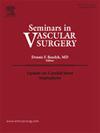Management of thrombosed or failed dialysis access
IF 2.4
3区 医学
Q1 PERIPHERAL VASCULAR DISEASE
引用次数: 0
Abstract
Hemodialysis (HD) access for patients with end-stage renal disease is a steadily increasing necessity, and maintaining patency of native or synthetic fistulas can be challenging. The main physiologic changes of an HD access that cause it to fail are inflow or outflow vessel stenosis or access thrombosis. These are propagated by factors intrinsic to end-stage renal disease, altered hemodynamics from a fistula, and typically further exacerbated by associated comorbidities. Diagnosis of fistula dysfunction can be made with a combination of history, physical examination, HD dynamic measurements, laboratory findings, and invasive or noninvasive imaging. Stenoses can be managed with endovascular interventions, including angioplasty with or without stenting, or open operations. Thrombosis of HD access, which is most often a result of an underlying stenosis, can be managed similarly with either endovascular or surgical thrombectomy with adjunctive treatment. Our goal was to review the pathophysiology of the most common forms of fistula failure, diagnosis, and endovascular and surgical options for flow restoration.
处理血栓形成或失效的透析通路。
为终末期肾病患者提供血液透析(HD)通路的必要性与日俱增,而保持原生或合成瘘管的通畅则极具挑战性。导致血液透析通路失效的主要生理变化是流入或流出血管狭窄或通路血栓形成。终末期肾病的内在因素、瘘管造成的血液动力学改变以及相关合并症通常会进一步加剧这些变化。瘘管功能障碍的诊断可结合病史、体格检查、高清动态测量、实验室检查结果以及有创或无创影像学检查。瘘管狭窄可通过血管内介入治疗(包括支架或不支架的血管成形术)或开放手术进行处理。HD 通路的血栓形成最常见的原因是潜在的狭窄,可通过血管内或外科血栓切除术及辅助治疗进行类似处理。我们的目标是回顾最常见瘘管失败形式的病理生理学、诊断以及恢复血流的血管内和外科手术方案。
本文章由计算机程序翻译,如有差异,请以英文原文为准。
求助全文
约1分钟内获得全文
求助全文
来源期刊
CiteScore
3.50
自引率
4.00%
发文量
54
审稿时长
50 days
期刊介绍:
Each issue of Seminars in Vascular Surgery examines the latest thinking on a particular clinical problem and features new diagnostic and operative techniques. The journal allows practitioners to expand their capabilities and to keep pace with the most rapidly evolving areas of surgery.

 求助内容:
求助内容: 应助结果提醒方式:
应助结果提醒方式:


